Structure and action of neurons - week 7
1/24
Earn XP
Description and Tags
MBB1
Name | Mastery | Learn | Test | Matching | Spaced |
|---|
No study sessions yet.
25 Terms
Action potentials
When a neuron fires it is called an action potential and is caused by changes in flow of charged molecules (ions) across the neuron’s cell membrane. The term “action potential” refers to the rapid change in the membrane potential of the neuron caused by this movement of ions.
At rest the membrane potential of the neuron is polarised at -70mV.
As positive (Na+) ions flow into cell the membrane potential depolarises, (membrane potential moves from - 70mV closer to 0 mV). If membrane potential reaches -50 mV an action potential will be triggered
After the action potential is finished there is a refractory period where the membrane potential is hyperpolarised meaning that it is even further from the threshold of activation and the neuron will be less likely to trigger another action potential until the membrane potential has returned to the resting potential of -70mV
Propagation of action potentials
Ions are only able to flow in and out across the neuron membrane in the gaps between the myelin, causing the actions potential to move faster
Rate law of Action Potentials -strong stimulus
=

Rate law of Action Potentials - weak stimulus
-

Rate law of Action Potentials
The neuron firing is “all or none” so frequency of firing determines the strength of the neural signal.
Strong stimulus > leads to faster threshold for activation > more frequent action potentials
Structure of a synapse
100 billion neurons > 1,000,000 billion synapses > 101,000,000 possible circuits
Synapses enable communication between neurons
Key structural details
Terminal button
Synaptic cleft
Pre & post synaptic membrane
Synaptic vesicles
Chemical signalling in the brain
Neurotransmitters are chemicals that are synthesised within the brain/neurons and are often called “chemical messengers”.
The action potential stops at the end of an axon so the presynaptic neuron can only influence the post-synaptic neuron through the release of neurotransmitters across the synapse.
Chemical signalling in the brain part 1
An action potential in the pre-synaptic cell triggers synaptic vesicles to move toward the cell membrane
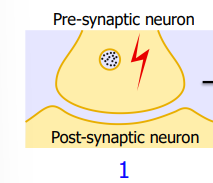
Chemical signalling in the brain part 2
This is followed by a fusion of the two membranes
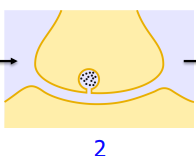
Chemical signalling in the brain part 3
Neurotransmitter molecules are then released

Chemical signalling in the brain part 4
Neurotransmitter then flows into the synaptic cleft where it is available to bind to receptors on the post-synaptic membrane
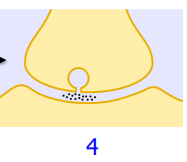
Neural Excitation (EPSP)
Excitatory postsynaptic potentials (EPSPs) depolarise the postsynaptic cell membrane
EPSPs increase the likelihood that an action potential will be triggered in the postsynaptic neuron
Glutamate is the primary excitatory neurotransmitter
Neural Inhibition (IPSP)
Inhibitory postsynaptic potentials (IPSPs) hyperpolarise the postsynaptic cell membrane
IPSPs decrease the likelihood that an action potential will be triggered
Gamma aminobutyric acid (GABA) is the primary inhibitory neurotransmitter
The combined effect of EPSPs and IPSPs is called neural integration
Neural integration
Remember each neuron receives input from many other neurons.
At any time, a single neuron can simultaneously receive excitatory and inhibitory inputs impacting the flow of ions into the neuron.
The neuron will only fire if the sum of the excitatory inputs is sufficiently greater than the inhibitory inputs to cause the membrane potential to pass the threshold of activation.
Because each neuron integrates the signals from the incoming neurons in this way, the combined effect of EPSPs & IPSPs is called neural integration
Neuromodulators- dopamine
-
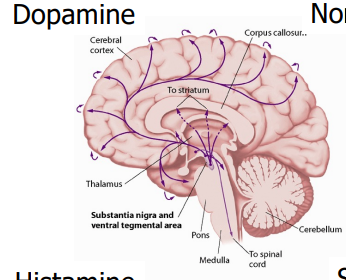
Neuromodulators -Noradrenaline
-
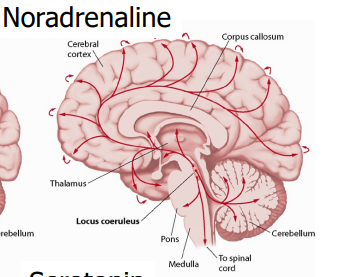
Neuromodulators - Histamine
-
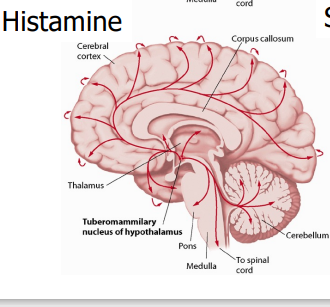
Neuromodulators - Serotonin
-
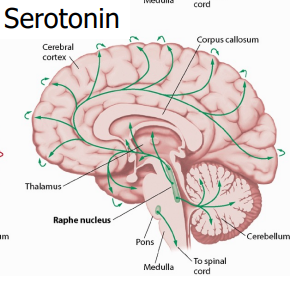
Action of neurotransmitters at receptors
Neurotransmitters don’t typically enter the post-synaptic neuron directly.
To cause an effect on the post-synaptic neuron, the chemical message must be “received” by attaching to the binding site of a receptor sensitive to that neurotransmitter.
Opening an ion channel is one example of the effect caused by neurotransmitter binding to the receptor
Receptors are very selective (lock and Key).
Each receptor can generally only be activated by one neurotransmitter (or a drug that is designed to mimic that neurotransmitter).
Each receptor also have a very specific function/action.
When a neurotransmitter binds to the receptor this will trigger the same event every time
Action of drugs at receptors
Drugs work by mimicking the chemical structure of the natural compound (perfectly or partially)
Action at the receptor
Drugs act by “mimicking” natural neurotransmitters or neuromodulators
AGONISTS
activating the receptor like the natural compound.
ANTAGONIST
blocking the receptor and preventing the natural compound from activating it
Drugs & neurotransmitter function
Drugs can impact every stage of neurotransmitter function from synthesis to release to receptor binding

Neural signalling and behaviour
Drugs impact psychological processes ONLY because they mimic/trigger the same biological responses triggered by naturally occurring substances (neurotransmitters, neuromodulators, hormones etc)
Psychological events directly impact the biological processes (observing a traumatic accident, remembering a poem at school etc) requires neurons to fire and chemical messages to be sent across neurons